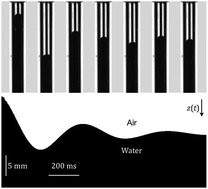Capillary descent†
Abstract
A superhydrophobic capillary tube immersed in water and brought in contact with the bath surface will be invaded by air, owing to its aerophilicity. We discuss this phenomenon where the ingredients of classical capillary rise are inverted, which leads to noticeable dynamical features. (1) The main regime of air invasion is linear in time, due to the viscous resistance of water. (2) Menisci in tubes with millimetre-size radii strongly oscillate before reaching their equilibrium depth, a consequence of inertia. On the whole, capillary descent provides a broad variety of dynamics where capillary effects, viscous friction and liquid inertia all play a role.



 Please wait while we load your content...
Please wait while we load your content...